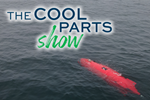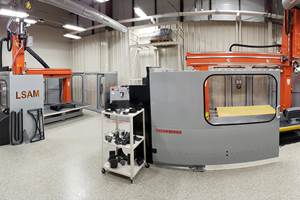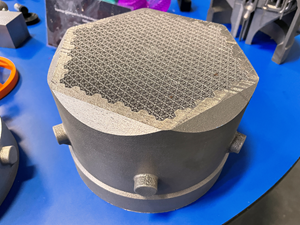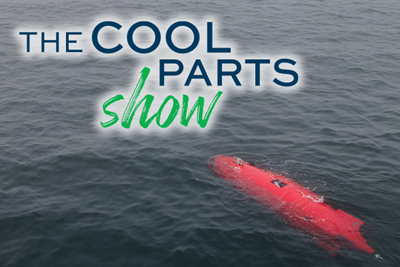Video: What is the Manufacturing Demonstration Facility at Oak Ridge National Laboratory?
This industry-focused organization within the Department of Energy helps manufacturers make use of advanced technology, particularly 3D printing. One of the group’s leaders describes how companies work with the MDF.
Share
Read Next
In this video, William Peter, director of the Manufacturing Sciences Division within Oak Ridge National Laboratory, offers an overview of the Manufacturing Demonstration Facility. The MDF is a team, a facility and a set of resources aimed at realizing the U.S. Department of Energy’s mission to aid manufacturers in adopting and benefiting from advanced technology. It has taken an active role in advancing additive manufacturing in particular — to the extent that various successes we have covered have come about in part through MDF support. In this conversation, Dr. Peter describes a notable example.
Related resources:
- Oak Ridge National Laboratory’s Manufacturing Demonstration Facility
- 3D printing hull sections for the Dive autonomous underwater vehicle
Transcript:
Peter Zelinski
I'm Pete Zelinski, the Manufacturing Demonstration Facility at Oak Ridge National Laboratory in Tennessee is playing an important role in additive manufacturing. The facility has had a hand in various additive manufacturing technology developments and applications. I wanted to find out what this group does and how it works. Joining me is William Peter, director of the facility's advanced manufacturing program. Oak Ridge National Laboratory, it's best known for its role in the Manhattan Project during World War II, it's part of the Department of Energy, it plays a different role today. What areas of manufacturing technology does the Manufacturing Demonstration Facility, the MDF focus on.
William Peter
So today we have additive composites, machining, hybrid technologies where we're bringing additive and subtractive together. We're also throughout all the processes really looking at the the digital manufacturing front how we go through and think about the digital thread, and the way things are going through within that space. More recently, we've also started looking at electrification of manufacturing and looking at the ability to reduce things like carbon emissions as we start thinking about future manufacturing systems.
Peter Zelinski
So in one of these technology areas, what does it look like for a commercial business, a manufacturing business to work with the MDF?
William Peter
Usually, they start off with small projects. And we're lucky enough to have sponsorship from the Advanced Manufacturing Office where as a company comes in and looks at these technologies, we have the ability, we call these industry collaborations or technical collaborations, for them to initiate under a small project with us, that's co funded. Typically, DOE is funding the ORNL staff to work with the company and the company is funding their activities on that same project. Those usually start off in a 80k type size project. This has been a great way though, for us to look at end users, material suppliers, digital software companies, the equipment manufacturers themselves and really be able to develop and de-risk. One of the big issues is capital investments for companies and trying to step into a new technology area. And by having the experts at Oak Ridge and getting integrated with them, we can really help de-risk a lot of those challenges that those companies are coming into and be able to evaluate those various technologies for new applications, new business opportunities, as well as looking at how does it impact our energy portfolio. Whether that's new energy systems, or the fact that it'll become much more efficient than the current way that they're producing parts today.
Peter Zelinski
Specifically, with regard to additive manufacturing, what kinds of capabilities do you have on site there are at Oak Ridge.
William Peter
So we've got all types of different capabilities between a whole variety of laser powder bed systems, electron beam powder bed systems, binder jet systems. Areas that were truly unique as you get into what size and what format or getting into things like some of the large scale directed energy deposition systems as we get into to metal. Both for reactive metals, where we can do it using inert gas with lasers, as well as looking at open air. We also have printers and hybrid systems. In fact, we have a very large hybrid system that we've been working on with Mazak right now that gets into an eight kilowatt laser system that has both CNC capability as well as the ability to pause it. And then lastly, we've got a lot of printers and large scale polymer printing, and the idea of both thermal plastics and thermo sets. As we go through that, especially in the thermoplastics, we're doing a lot of work in composite fabrication, and how do you integrate both the additive processes with composites as well.
Peter Zelinski
On one episode of The Cool Parts Show, we looked at large format 3D printing being used to make hull sections for an autonomous underwater vehicle. Dive Technologies turned to Additive Engineering Solutions, which used large format additive manufacturing equipment from Cincinnati Incorporated. And what's striking about this is the MDF worked with all three of those companies I just mentioned. Would you talk about that?
William Peter
Oak Ridge was very fundamental in developing an entire large scale polymer industry. And so early on we worked with Cincinnati Incorporated to develop the Big Area Additive Manufacturing system and go through and look at thermoplastic printing. We did a lot of work early on in the development of large scale polymer printing, including things like the extrusion, the controls, and material development within that system. As we look at specific Dive Technologies, we were trying to go through and develop prototypes and understand, could we go through and get the integrity, could we go through and fabricate the geometries that were needed for those applications. Then lastly, AES, Austin Schmidt, he came in at a very critical time and saw what we were developing and working on with big area thermoplastic printing and went through and then start the company AES. And so it's really nice to see each of those pieces coming together. There's also the whole development within the material side and working with companies like Techmer and others that are producing and developing those materials that are actually going into those structures. So getting to see the entire supply chain, it was very exciting to be able to see how all these pieces are coming together.
Related Content
BPMI Chooses Velo3D Metal 3D Printing System to Produce Parts for U.S. Naval Nuclear Propulsion Program
The fully integrated 3D printing solution will be operated by ATI in a newly established facility that will provide the U.S. Naval Nuclear Propulsion Program with alternatives to cast parts.
Read MoreDOE Awards Nearly $3 Million to Develop Additive Manufacturing of Modular Wind Blades
The industry partners received the award to develop automation in additive manufacturing of tooling for large-scale wind blades that can accommodate continuous changes in blade geometry and scale.
Read More3D Printed Heat Exchanger Illustrates Siemens' CATCH and Release Approach
Solutions for energy efficiency, sustainability, part repair and more are developing at Siemens’ Charlotte Advanced Technology Collaboration Hub (CATCH) in North Carolina.
Read MoreVideo: 5" Diameter Navy Artillery Rounds Made Through Robot Directed Energy Deposition (DED) Instead of Forging
Big Metal Additive conceives additive manufacturing production factory making hundreds of Navy projectile housings per day.
Read MoreRead Next
Autonomous Underwater Vehicle With 3D Printed Hull: The Cool Parts Show #24
Our first episode of The Cool Parts Show from inside a 3D printer! Big Area Additive Manufacturing (BAAM) produces exterior components of a robot submarine and changes how this AUV is marketed.
Read MoreAlquist 3D Looks Toward a Carbon-Sequestering Future with 3D Printed Infrastructure
The Colorado startup aims to reduce the carbon footprint of new buildings, homes and city infrastructure with robotic 3D printing and a specialized geopolymer material.
Read MoreBike Manufacturer Uses Additive Manufacturing to Create Lighter, More Complex, Customized Parts
Titanium bike frame manufacturer Hanglun Technology mixes precision casting with 3D printing to create bikes that offer increased speed and reduced turbulence during long-distance rides, offering a smoother, faster and more efficient cycling experience.
Read More




















